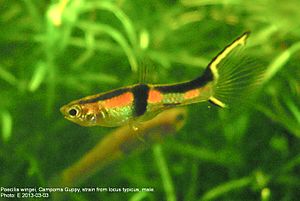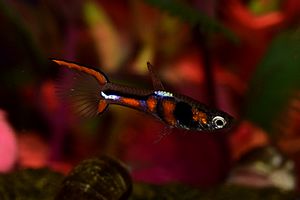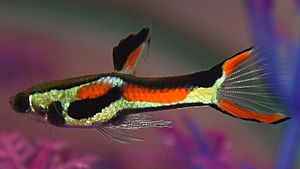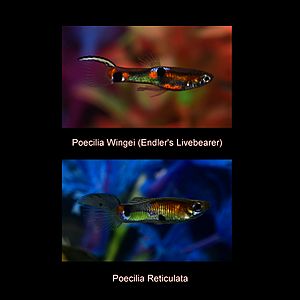Poecilia wingei facts for kids
Quick facts for kids Poecilia wingei |
|
|---|---|
 |
|
| Poecilia wingei, a male Campoma guppy from its original home | |
| Scientific classification |
The Poecilia wingei, often called Endlers or Endler's livebearer by fish fans, is a small fish. It belongs to the Poecilia family. This fish comes from the Paria Peninsula in Venezuela. Endlers are known for having many babies. They often mix with guppies to create new types. These colorful mixed fish are easy to find in pet shops. They are usually called Endler's guppy.
Contents
History of Endler's Livebearer
Poecilia wingei is a very colorful type of guppy. It looks a lot like the fancy guppies you see in pet shops. This fish was first found in Laguna de Patos, Venezuela. That was in 1937 by Franklyn F. Bond.
Later, in 1975, Dr. John Endler found them again. These were the first Endlers to be sold for aquariums. More have been collected since then. Armando Pou helped get more of these fish for people to keep.
The original fish from Laguna de Patos are in danger. Their home is threatened by trash from a nearby town. While not common in pet shops, you can sometimes find them with fish enthusiasts.
Endlers are not yet on the official list of endangered animals. But they are at risk of disappearing in the wild. This is because people are moving into their natural homes. This causes pollution and destroys their living areas.
For a while, some scientists debated if Poecilia wingei was a separate species. Some thought it was just like the common guppy. However, in 2009, new studies showed that Poecilia wingei is indeed a different species. It is separate from other guppy types like P. reticulata and P. obscura.
Different Types of Endlers
Endlers are found in different areas of Venezuela. Each group has its own unique look.
Campoma Endlers
The first group of Poecilia named Poecilia wingei was found in 2005. This happened in the Campoma region of Venezuela. Fred Poeser and Michael Kempkes discovered them. These Endlers live in Laguna Campoma and its nearby streams.
Most Campoma Endlers kept by fish fans today come from fish collected by Phil Voisin. The Campoma bridge area is a popular spot for finding these fish. Endlers from this spot are often given numbers from 1 to 70 to tell them apart. These fish are also known as the Campoma guppy.
Cumana Endlers
Poecilia wingei from the Cumana region were first called Endler's guppy. John Endler found them in 1975 in Laguna Patos. They also lived in the streams and canals connected to the lagoon.
Most Cumana Endlers in the hobby today come from fish collected by Armando Pau. Adrian Hernandez then bred and shared these fish with other hobbyists. These fish are also known as the Cumana guppy.
El Tigre Endlers
El Tigre Endlers are Poecilia wingei found in the El Tigre stream. This stream is also in the Campoma region of Venezuela. The El Tigre stream is not connected to Laguna Campoma. This means the El Tigre Endlers are their own special group. All El Tigre Endlers kept by hobbyists today come from fish collected by Phil Voisin.
Hybrids: Mixed Fish
Endlers (P. wingei) can breed with guppy species. These include P. reticulata and P. obscura. Their baby fish, called hybrids, can also have babies. This mixing can change the pure gene pool of Endlers. Because of this, fish breeders try to keep their Endlers pure.
Fish fans keep careful records to make sure their Endlers are purebred. Fish sold in pet stores as Endler's livebearers might be mixed. This is especially true if they don't have clear records. Sometimes, P. reticulata and P. wingei live in the same waters. This means they can also mix in nature.
Mixing Endlers with fancy guppies often creates very bright and colorful fish. Some of these mixed fish are even bred on purpose. They become so common that they are sold under many names. These names include peacock, snake, tiger, paradise, fancy, or sword Endler. Sometimes they are even called flame tail.
Endlers in Your Aquarium
Poecilia wingei are strong and easy to care for fish. They can survive well in many tanks. But to keep them healthy and looking their best, a few things are important.
You need to set up their tank well. Their food, water quality, and tank mates matter. The number of male to female fish also plays a role. All these things help keep your fish strong and beautiful.
Reproduction and Life Cycle
Male Endler's livebearers have very bright colors. Their black, orange, and metallic green colors are especially strong. Their natural patterns are all different. Many have a tail that looks like a double sword. Breeders have created many types with special patterns and colors. These include red chest, black bar, and yellow sword.
Endlers have many babies, just like their guppy relatives. They give birth to live young about every 23 days. A mother can have anywhere from 1 to 30 babies at a time. This depends on her age and size.
For their first few hours, the baby fish stay at the bottom of the tank. They eat their yolk sacs during this time. This is when they are most in danger from other fish. Even their own mothers and other female Endlers might try to eat them. Male Endlers usually don't try to eat the babies.
You can feed the baby fish powdered fry food. Baby brine shrimp and crushed flake food also work well. They will also nibble on the algae and tiny living things on water plants. Even adult brine shrimp are not too big for them. Several baby fish might work together to eat a brine shrimp their own size.
Male babies start to show color in about three to four weeks. But it can take several months for their colors to become full and rich. The colors of a male Endler will get stronger over the first six months of its life. Sometimes, their tails look like swords, but they are much shorter. Often, it's just bright color along the edge of a clear tail. This makes it look like a sword.
Female Endlers usually have plain colors their whole lives. They can be a pale silver or a dull, dark gold. Their color can change a bit if they move from a light tank to a dark one. When fully grown, adult females can be twice as big as males.
Giving birth can be hard on the female fish. Some may not live long after having many babies. The ones that struggle might turn gray and get weaker. They might eventually die because of the stress.
Name Origin
The name Poecilia wingei honors a Danish biologist named Øjvind Winge. He lived from 1886 to 1964. He did a lot of work on the genetics of Poecilia fish, including this species.
Images for kids
See also
 In Spanish: Poecilia wingei para niños
In Spanish: Poecilia wingei para niños







